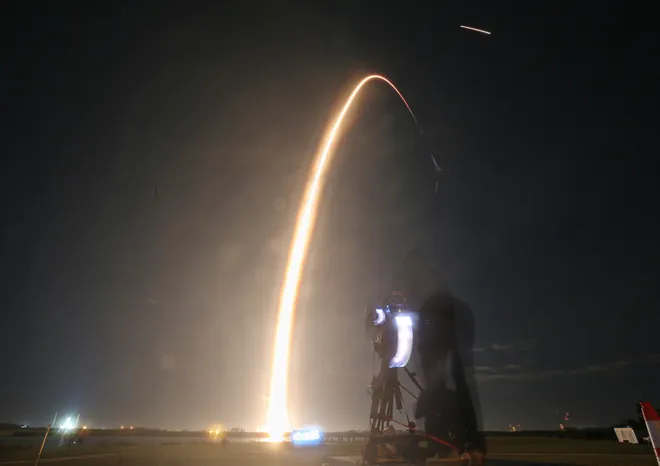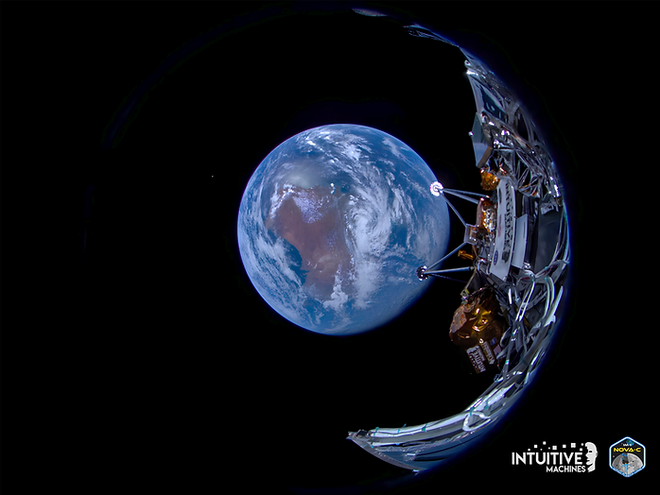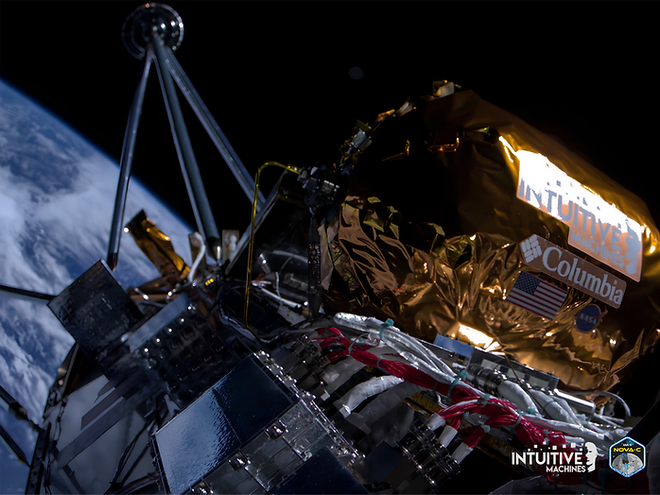Odysseus lunar lander sends first photos in orbit as it attempts to make history
The Odysseus moon lander has beamed home some selfies of the spacecraft juxtaposed in front of Earth as it makes its way to the lunar surface.
The images were captured a day after Houston-based Intuitive Machines' uncrewed lander launched aboard the SpaceX Falcon 9 rocket on its way to potentially become the first commercially-built craft to ever reach the moon.
The space company shared four images Saturday on the social media site X. The photos were chosen from hundreds of images captured by the lander's cameras, which were programmed to take five images every five minutes for the first two hours after separating from the SpaceX's rocket's second stage.
"Out of all the images collected, Intuitive Machines chose to show humanity’s place in the universe with four wonderful images we hope to inspire the next generation of risk-takers," the company said in a statement.
Interactive maps:How long will the solar eclipse darkness last in your city?
Odysseus remains on track for a Thursday moon landing attempt

Named for the Greek hero of Homer's epic poem "The Odyssey," Odysseus has the potential to be a history-making spacecraft if it touches down on the moon.
No commercially-built lander has ever made it to the lunar surface, and it's been more than 50 years since the last American moon landing in 1972 as part of NASA's Apollo program.
But Intuitive Machines' lander is hardly the first to make the attempt.
In January, Pittsburgh-based aerospace company Astrobotic sent its Peregrine lander on a doomed mission to the moon that ended with the spacecraft burning up in Earth's atmosphere days later. Shortly after separating from the United Launch Alliance's Vulcan rocket, Peregrine's propulsion began leaking a critical amount of propellant that forced Astrobotic to eventually abandon plans of landing on the moon.
The outlook for Odysseus appears to be more optimistic, with Intuitive Machines reporting that the spacecraft is still on track to attempt a moon landing Thursday near the moon's south polar region. Scientists have long been interested in studying the south pole due to the presence of water ice thought to be abundant within its craters.
After liftoff Thursday, the 14-foot-tall Nova-C lander reached its intended orbit about 48 minutes later and established communication with ground control in Houston, Intuitive Machines said. A successful engine firing Friday helped position the lander toward the moon and allowed flight controllers to determine that the engine burn and throttle systems needed to land were functioning as intended.
Flight controllers reported Sunday that Odysseus "continues to be in excellent health" as they prepare for a Wednesday "lunar orbit insertion" a day ahead of the touchdown.
The landing will be streamed on the company's IM-1 mission landing page. Columbia Sportswear, which is testing a metallic jacket fabric as a thermal insulator on the lander, will also take over the exterior of the Las Vegas sphere during the landing attempt, according to a press release.
“We are keenly aware of the immense challenges that lie ahead,” Intuitive Machines CEO Steve Altemus said in a statement after the launch. “However, it is precisely in facing these challenges head-on that we recognize the magnitude of the opportunity before us: to softly return the United States to the surface of the Moon for the first time in 52 years.”

NASA hopes mission paves the way for astronauts to return to moon
Intuitive Machines' lunar mission is part of NASA's Commercial Lunar Payload Services program, or CLPS.
The U.S. space agency has a budget of $2.6 billion in contracts available through 2028 to pay private companies to place scientific payloads on private robotic landers like Odysseus bound for the lunar surface. If Intuitive Machines can pull off the mission, it would open the door for NASA to work with more commercial entities on future space endeavors.

As the primary customer for the Odysseus mission, NASA paid Intuitive Machines $118 million to take its scientific payloads to the moon. The scientific instruments will collect valuable data for NASA as it prepares to send astronauts back to the lunar surface for its since-delayed Artemis program.
The mission, and others like it ahead, is intended to pave the way for human exploration of the moon.
NASA delayed plans for Artemis II until 2025, which is when a group of spacefarers could finally embark on a 10-day trip circumnavigating the moon. The mission would be the precursor to Artemis III years later, when another crew of astronauts will set out to land on the lunar surface itself.

Eric Lagatta covers breaking and trending news for USA TODAY. Reach him at elagatta@gannett.com
Disclaimer: The copyright of this article belongs to the original author. Reposting this article is solely for the purpose of information dissemination and does not constitute any investment advice. If there is any infringement, please contact us immediately. We will make corrections or deletions as necessary. Thank you.




